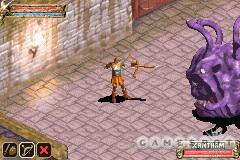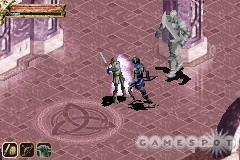It's truly a mystery why there aren't more solid hack-and-slash-style games available for the Game Boy Advance. Role-playing games seem to be popular, and the flexible, albeit time-consuming, manner in which the characters in a typical hack-and-slash are outfitted lends itself well to a system where players tend to play in brief spurts or in marathon four-hour sessions. Electronic Arts did a nice job with its Lord of the Rings games, but they were story-based and didn't really give players much leeway in customizing their characters. Ubisoft's Baldur's Gate: Dark Alliance is more in line with what hack-and-slash devotees are looking for. It has all of the characters and story events--and a majority of the essential gameplay elements--that made the Baldur's Gate series so addictive in the first place, but now they're all on a highly portable GBA cartridge.

The GBA version of Baldur's Gate: Dark Alliance unfolds exactly as the original PS2, Xbox, and GameCube versions of the game did. After an unfortunate mugging, your character awakens in the town of Baldur's Gate and learns that the same thieves who stole your goods are also responsible for a series of murders that have recently befallen the town. The initial search to root out these scoundrels ultimately leads your character on a quest to save the world, which, in practical terms, spans three unique lands and more than 28 unique game locations.
At the outset, there are three character classes to pick from: fighter, wizard, and archer. A fourth class, elven fighter, becomes available the first time you complete the game. This may not seem like a wide array of choices, but the abilities and attributes that make up each class amount to wildly divergent play styles for each of the four characters. The fighter is a tank who can deflect most attacks by blocking. The fighter can also dole out upwards of 200 points of damage per strike. However, the character's ability to avoid long-range attacks is poor, as are the accuracy and strength of its own long-range attacks. On the contrary, the wizard and archer are strong in the areas where the fighter is weak. So if you choose a wizard, you'll use spells to do your dirty work, while the added charisma bonus will allow you to buy armor and potions more cheaply than any of the other classes. The archer is more of a hit-and-run-style character. The archer is not as powerful as the fighter or the wizard but is much quicker and more capable of landing arrows at great distances. Last but not least, the elven fighter is a reward for completing the game, because this warrior combines all of the positive aspects of the other classes.

Every detail of Baldur's Gate reads like a how-to of what you should expect to find in a hack-and-slash game. While The Lord of the Rings: The Two Towers and The Lord of the Rings: The Return of the King both do a decent job of allowing you to level up characters and gather unique weapons, the emphasis in those games is on the story and not on combat, the loot, or character customization. In Baldur's Gate, enemies don't just attack in mass and run right into your sword. If you're fighting a pair of kobolds, one of them will invariably try to get behind you in order to bypass your blocking abilities. Likewise, a gnoll archer won't try to attack you up close but will instead hang back and attempt to peg you with arrows. Your character earns experience for every creature you dispatch, which results in automatic attribute increases at preset levels and also gives you points to pour into specific magic and fighting skills. Each character has a dozen or so spells and skills that you can upgrade as you see fit. At the same time, you'll find new weapons, armor pieces, and status items virtually everywhere, like in vases, in barrels, and in treasure chests. You'll also find these items when they are dropped by enemies or at the merchant shops that are located in each of the game's three main hubs. One extremely neat aspect of this is that your character's appearance changes depending on what items you have equipped. The various armor pieces differ in terms of size, shape, and color, as do each of the weapons. You can look at what your character is carrying without bringing up the inventory menu and know exactly what weapon, shield, and armor you have equipped at any given moment.
Details aside, this is a hack-and-slash that's easy to jump into regardless of whether you're in it for the hands-on experience or for the richness of the story and locations. Combat happens in real time, and the control layout conveniently allows you to attack, block, or use items just by rapidly pressing the A, L, and B buttons. The R button allows you to switch between melee, arrow, and magic attacks. About the only time you need to hit start to bring up the inventory menu is when you want to assign different weapons and magic, change equipment, or distribute points to your character's magic and skill abilities.

As far as how the game looks and feels, those of you who enjoy a rich story will find plenty of nonplayer characters to interact with. Additionally, there are many twists and turns during what is basically a tale of corruption and betrayal. Those of you who expect a high degree of visual and audio quality will be pleased as well. A number of GBA games in the past have used the isometric viewpoint, but the environments in those games were never as lively as this. Light sources, such as torches and lamps, cast their wavering hues over large areas; every character has its own real-time shadow; the edges of streams and sewers sway and shimmer like they're actually flowing; and it's simply cool how footsteps create little waves when you walk across puddles and streams. Enchanted weapons, like frost- and fire-blessed swords, also cause tufts of ice and flame to explode off of enemies when you make a successful attack. The diversity of enemies is excellent, and there are dozens of them. Some are as small as rats, and others are so large that they occupy a third of the screen. Even though there isn't much of a soundtrack to speak of, at least in terms of music, the amount of audio is also impressive. Every enemy has its own set of attack, recoil, and death vocalizations, and there are all sorts of different sound effects used for things like attacks, footsteps, and falling objects.
Although well crafted, there are a few problem areas worth mentioning. Due to the limited storage capacity of the cartridge format, along with the lesser graphical capabilities of the GBA itself, some liberties were taken with respect to the way in which characters and locations are portrayed. For example, the traders and key figures in each village no longer have their own unique portraits or body models. Instead, they're just palette swaps of standard enemies. The same holds true for the player's avatar as well. No matter which type of character class you choose--fighter, wizard, archer, or elven fighter--an identical body is used. Even though you can alter your character's appearance to your heart's content, with various weapons and armor pieces, there are no distinctions made for height, weight, race, or gender. Fans of the console Baldur's Gate game will recognize the layout of many of the dungeons and villages in the GBA game, but some alterations have been made here as well. For the most part, these adjustments just add to the length of some dungeons or change around the solution to certain puzzles. However, there are spots where entire sections have been excised that would have proven too much for the isometric graphics engine to handle. These spots pretty much include any areas that involve jumping or pushing items around.

The biggest complaint most people will have is that the game is over much too quickly. Assuming you take the time to purchase decent equipment and put some effort into customizing your character, you'll still only need around eight hours to finish all three chapters. Each of the three main bosses can overpower you if your character is underdeveloped--which could make for some backtracking--but the save point situated outside of each lair allows you to go back and gain experience if you need to. Except for going back and replaying the game with another character, there's not much else to do. Magic Pockets, the game's developer, didn't include any bonus dungeons or multiplayer features, and that's a shame because this is the sort of game that compels you to keep playing it.
Nevertheless, don't write off Baldur's Gate: Dark Alliance just because it doesn't last very long or just because it takes a few shortcuts when compared to the console versions. If you're looking for a hack-and-slash game on the go, this is the one to get.